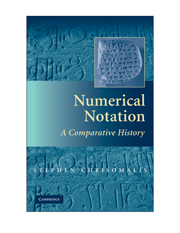Book contents
- Frontmatter
- Contents
- Acknowledgments
- 1 Introduction
- 2 Hieroglyphic Systems
- 3 Levantine Systems
- 4 Italic Systems
- 5 Alphabetic Systems
- 6 South Asian Systems
- 7 Mesopotamian Systems
- 8 East Asian Systems
- 9 Mesoamerican Systems
- 10 Miscellaneous Systems
- 11 Cognitive and Structural Analysis
- 12 Social and Historical Analysis
- 13 Conclusion
- Glossary
- Bibliography
- Index
11 - Cognitive and Structural Analysis
Published online by Cambridge University Press: 18 May 2010
- Frontmatter
- Contents
- Acknowledgments
- 1 Introduction
- 2 Hieroglyphic Systems
- 3 Levantine Systems
- 4 Italic Systems
- 5 Alphabetic Systems
- 6 South Asian Systems
- 7 Mesopotamian Systems
- 8 East Asian Systems
- 9 Mesoamerican Systems
- 10 Miscellaneous Systems
- 11 Cognitive and Structural Analysis
- 12 Social and Historical Analysis
- 13 Conclusion
- Glossary
- Bibliography
- Index
Summary
In Chapters 2 through 10, I described over 100 different numerical notation systems spanning over 5,000 years and every inhabited continent. While there are historically determined similarities among the systems of each phylogeny, the same structures and principles emerge independently multiple times. This situation creates a paradox only if we cling to the dichotomous assumption that historical explanations stand in stark contrast to universalizing ones. A set of interrelated cognitive factors help explain why systems are the way they are and why they change in the ways that they do. There are some domains of human experience for which the role of contingency is so great, or the functional constraints so minimal, that we cannot speak meaningfully of regularities or laws. Numerical notation is not one of them. In Chapter 1, I outlined the case that the study of cross-cultural regularities and universals is of equal importance to the study of unique or particular phenomena (Brown 1991). Here I will outline around thirty regularities that apply to numerical notation systems, while in the following chapter I will inject theoretical issues relating to social and historical context into this analysis.
Numerical notation systems exhibit both synchronic regularities, which apply to numerical notation systems considered as static structures, and diachronic regularities, which apply to relations between systems over time. Synchronic or diachronic regularities can be either universals (for which there are no exceptions) or statistical regularities (which hold true only for a preponderance of cases). While true universals are interesting, statistical regularities are also important, and may in fact be caused by cognitive factors similar to those that produce universals.
- Type
- Chapter
- Information
- Numerical NotationA Comparative History, pp. 360 - 400Publisher: Cambridge University PressPrint publication year: 2010



